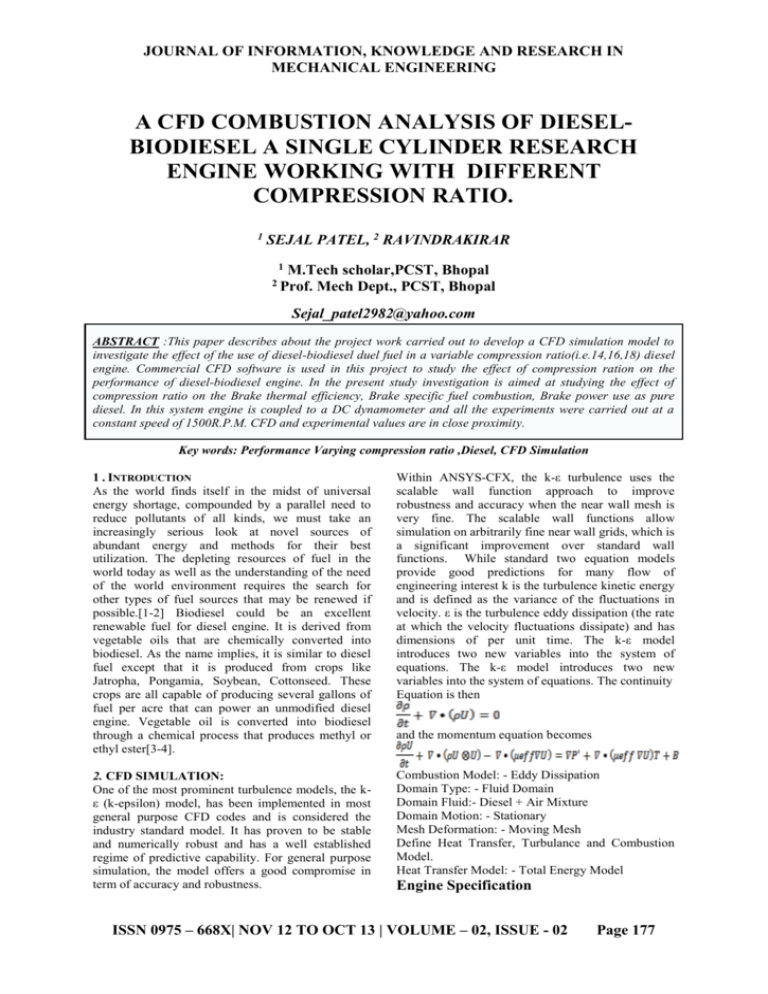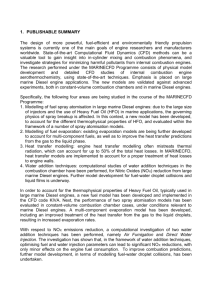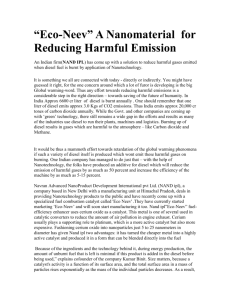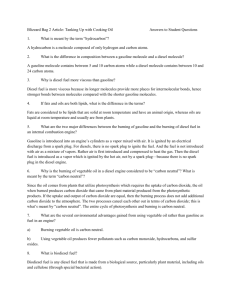- the Journal of Information, Knowledge and Research in
advertisement

JOURNAL OF INFORMATION, KNOWLEDGE AND RESEARCH IN MECHANICAL ENGINEERING A CFD COMBUSTION ANALYSIS OF DIESELBIODIESEL A SINGLE CYLINDER RESEARCH ENGINE WORKING WITH DIFFERENT COMPRESSION RATIO. 1 SEJAL PATEL, 2 RAVINDRAKIRAR 1 M.Tech scholar,PCST, Bhopal Mech Dept., PCST, Bhopal 2 Prof. Sejal_patel2982@yahoo.com ABSTRACT :This paper describes about the project work carried out to develop a CFD simulation model to investigate the effect of the use of diesel-biodiesel duel fuel in a variable compression ratio(i.e.14,16,18) diesel engine. Commercial CFD software is used in this project to study the effect of compression ration on the performance of diesel-biodiesel engine. In the present study investigation is aimed at studying the effect of compression ratio on the Brake thermal efficiency, Brake specific fuel combustion, Brake power use as pure diesel. In this system engine is coupled to a DC dynamometer and all the experiments were carried out at a constant speed of 1500R.P.M. CFD and experimental values are in close proximity. Key words: Performance Varying compression ratio ,Diesel, CFD Simulation 1 . INTRODUCTION As the world finds itself in the midst of universal energy shortage, compounded by a parallel need to reduce pollutants of all kinds, we must take an increasingly serious look at novel sources of abundant energy and methods for their best utilization. The depleting resources of fuel in the world today as well as the understanding of the need of the world environment requires the search for other types of fuel sources that may be renewed if possible.[1-2] Biodiesel could be an excellent renewable fuel for diesel engine. It is derived from vegetable oils that are chemically converted into biodiesel. As the name implies, it is similar to diesel fuel except that it is produced from crops like Jatropha, Pongamia, Soybean, Cottonseed. These crops are all capable of producing several gallons of fuel per acre that can power an unmodified diesel engine. Vegetable oil is converted into biodiesel through a chemical process that produces methyl or ethyl ester[3-4]. Within ANSYS-CFX, the k-ε turbulence uses the scalable wall function approach to improve robustness and accuracy when the near wall mesh is very fine. The scalable wall functions allow simulation on arbitrarily fine near wall grids, which is a significant improvement over standard wall functions. While standard two equation models provide good predictions for many flow of engineering interest k is the turbulence kinetic energy and is defined as the variance of the fluctuations in velocity. ε is the turbulence eddy dissipation (the rate at which the velocity fluctuations dissipate) and has dimensions of per unit time. The k-ε model introduces two new variables into the system of equations. The k-ε model introduces two new variables into the system of equations. The continuity Equation is then 2. CFD SIMULATION: One of the most prominent turbulence models, the kε (k-epsilon) model, has been implemented in most general purpose CFD codes and is considered the industry standard model. It has proven to be stable and numerically robust and has a well established regime of predictive capability. For general purpose simulation, the model offers a good compromise in term of accuracy and robustness. Combustion Model: - Eddy Dissipation Domain Type: - Fluid Domain Domain Fluid:- Diesel + Air Mixture Domain Motion: - Stationary Mesh Deformation: - Moving Mesh Define Heat Transfer, Turbulance and Combustion Model. Heat Transfer Model: - Total Energy Model and the momentum equation becomes Engine Specification ISSN 0975 – 668X| NOV 12 TO OCT 13 | VOLUME – 02, ISSUE - 02 Page 177 JOURNAL OF INFORMATION, KNOWLEDGE AND RESEARCH IN MECHANICAL ENGINEERING 1 cylinder, 4 stroke, water cooled, stroke 110 mm, bore 87.5 mm. Diesel mode: Power 3.5 KW , CR range 12:1-18:1 , Speed 1500 rpm , Injection variation 0-25 Deg BTDC. 3.RESULT &DISSCUSSION A) Brake Thermal Efficiency As seen in Figure 2. CFD and experimental values are in close proximity. Except at CR 16 they are very close to each other. The difference between the theoretical and experimental values for BTHE is 11%atCR18,it is 8% at CR16, it is 14%at CR14at full load condition use fuel as pure diesel. B) Brake Specific Fuel Combustion As seen in Figure 3. CFD and experimental values are in close proximity. Except at CR 14,CR16 they are very close to each other. The difference between the theoretical and experimental values for BSFC is 8%atCR18,it is 1% at CR16, it is 1%at CR14at full load condition use fuel as pure diesel Figure 1 mesh model . Figure 2: Comparison of BTHE Versus Load for Pure diesel at Full load . Figure 3: Comparison of BSFC Versus Load for Pure diesel at Full load ISSN 0975 – 668X| NOV 12 TO OCT 13 | VOLUME – 02, ISSUE - 02 Page 178 JOURNAL OF INFORMATION, KNOWLEDGE AND RESEARCH IN MECHANICAL ENGINEERING . Figure 4: Comparison of BP Versus Load for Pure diesel at Full load . Figure 5: Comparison of Exhaust Gas Temperature Versus Load for Pure diesel at Full load As seen in Figure4. CFD and experimental values are in close proximity. Except at CR 14,CR16,CR18 they are very close to each other. The difference between the theoretical and experimental values for BP is increase with the increase in load use fuel as pure diesel. Pure diesel of exhaust gas temperature at compression ratio 14, 16 and 18 . can observed from figure that the value of exhaust gas temperature decreases with increment of compression ratio. The difference between the theoretical and experimental values for exhaust gas temp is 8% at CR18,it is 4% at CR16, it is 6%at CR14at full load condition use fuel as pure diesel. D)Exhaust Gas Temperature 3.CONCLUSIONS C) Brake Power As seen in Figure5. CFD and experimental values for ISSN 0975 – 668X| NOV 12 TO OCT 13 | VOLUME – 02, ISSUE - 02 Page 179 JOURNAL OF INFORMATION, KNOWLEDGE AND RESEARCH IN MECHANICAL ENGINEERING The CFD analysis along with experimental investigations is being carried out to compare pure diesel combustion and emission analysis.CR 16 is proximity result with compare both results for the BTHE, BSFC, BP, Exhaust gas temperature. The model needs further refinement in the computational mesh. 4.References 1.Pramanik,K,2003 .Properties and use of jatropha curcas oil and diesel fuel blends in compression ignition engine, Renewable Ener,28(2):239-248. 2.Taku Tsujimura, shohei Mikai, T. Yoshiroh, J. Senda and H. Fujimoto, A study of Direct Injection Diesel Engine Fueled with Hydrogen, SAE paper NO. 2003-01-061, March 2003 3. Anjana Srivastava and Ram Prasad, 2000. Triglycerides based diesel fules, Renewable and Austainable Energy revie.4:111-113 4.Senthil Kumar, M.,A. Ramesh and B. Nagalingam, 2003. An experimental comparision of method to use jatropha oil and its methyl esters as a fuel in a CI engine, International Journal of Biomass and Bio. Ener., 25: 309-318. 5 Senthil Kumar, M.,A. Ramesh and B. Nagalingam, 2001. Investigation on the use of jatropha oil and its methyl esters as a fuel in a compression ignition engine, J. Institute of Ener., 74:24-28. ISSN 0975 – 668X| NOV 12 TO OCT 13 | VOLUME – 02, ISSUE - 02 Page 180






